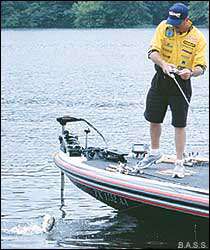
BIRMINGHAM, Ala. — David Walker knows what it's like to come close to winning a BASSMASTERS Classic. But at Lay Lake, it felt a lot better to finish third this time than it did the previous year in New Orleans.
"Last year, I was looking for a rope or revolver," quipped Walker, who now has two bronze medals in three Classic appearances. "I was really disgusted then because I had the opportunity to win. But this year, it was fun. It reminded me of why I got into tournament fishing."
Walker relied on his instincts to collect limits each day, jumping from 13th to second entering the final round on the heels of a 16-pound, 5-ounce limit. His 35-pound, 13-ounce total earned him a boat/motor package valued at $35,000 and validated his reputation as one of the sport's rising stars.
The 37-year-old Tennessee pro caught fish a variety of ways the first two days, then turned to his favorite fishing technique — flipping a jig — on the last day.
"Most of my fish were spotted bass the first two days, but I got onto a largemouth pattern that I thought would get me more weight," he described. "I felt more comfortable fishing for them."
Walker had to scramble early in the event after discovering other contestants, including front-runners Jay Yelas and Aaron Martens, were fishing the same areas in the upper end of the Coosa River. He caught a 9-pound, 9-ounce limit on a Texas rigged Lake Fork Black Neon Tube and a shad-colored Lucky Craft Gun Fish topwater the first day.
The second day, all but a 6-pound largemouth came on a smoke-colored Texas rigged Lake Fork Twitch Worm fished around river shoals where spotted bass were gorging themselves on shad. He rigged it with a 1/8-ounce Lake Fork MegaWeight and a red 2/0 Daiichi hook.
The jig fish gave him the confidence he needed. When the largemouth started hitting the 5/8-ounce Lake Fork jig in the grass, he knew he was onto something.
"That's how I caught all my fish the last day," he noted. "It gave me the confidence to fish jigs for largemouth and try for a bigger sack."
Most of his fish on the final day were positioned around stumps scattered on a point at the end of an island. The jig was black, brown and amber and dressed with a green/pumpkin plastic trailer. He dipped the trailer's legs into chartreuse dye to add a little contrast.
Fourth place
Competing in his fourth world championship, O.T. Fears jumped from ninth to fourth overall on the final day with a 12-pound, 4-ounce limit.
Like Jay Yelas, the eventual Classic champion, Fears was fishing in the Coosa River headwaters where larger spotted bass were present.
Fears opened the tournament in 28th and moved to ninth on the second day.
"I'm a river fisherman, so I moseyed up the Coosa and found a rocky ledge that the fish were using as a base," explained the Oklahoma pro. "When the water was moving, they held on the ledge. When it wasn't, they stayed close but roamed around."
His primary lure was a Zoom Super Fluke Jr., a 2 1/2-inch soft plastic jerkbait that he customized by coloring the tail black. He rigged it on a 3/0 Gamakatsu G-Lok hook, put a nail weight in the body so the bait would sink, and would cast it into the current. He fished it on 17-pound test Trilene Sensation line.
"The size was critical," he emphasized. "They wouldn't hit the standard size fluke and the little one matched the baitfish in the area. I worked it 2 feet or so below the surface and tried to imitate a dying shad."
Fears finished the three day event with a total weight of 31 pounds, 6 ounces.
Fifth place
Larry Nixon moved up each day of the tournament, charging from 16th to 12th and finally to fifth overall with a three day total of 31 pounds, 3 ounces.
His 13-pound, 12-ounce limit on the last day was his biggest of the event and the second heaviest of the final round.
Unlike the other leaders, Nixon concentrated on the lower end of the lake, admitting that targeting current is not his strongest suit.
"I just went fishing, looking for little shady areas in the small cuts and nooks off the main lake," he said.
Nixon relied on two lures for most of his creel. He flipped an 8-inch Berkley Power Worm (red shad) rigged Texas style in combination with a 1/4-ounce slip sinker and 17-pound test Trilene XT line. He pitched this lure to open pockets and edges along shoreline vegetation.
Nixon's bigger fish on the last day, however, came on a black Snagproof frog that he was throwing far back into the grass and over scum that provided additional shade for the bass. He used Berkley's new IronSilk line (20-pound test) to fight the fish out of the cover.
"The frog fish were in 2 to 3 feet of water. But the flipping fish came from grass where there was deeper water nearby," he added.

